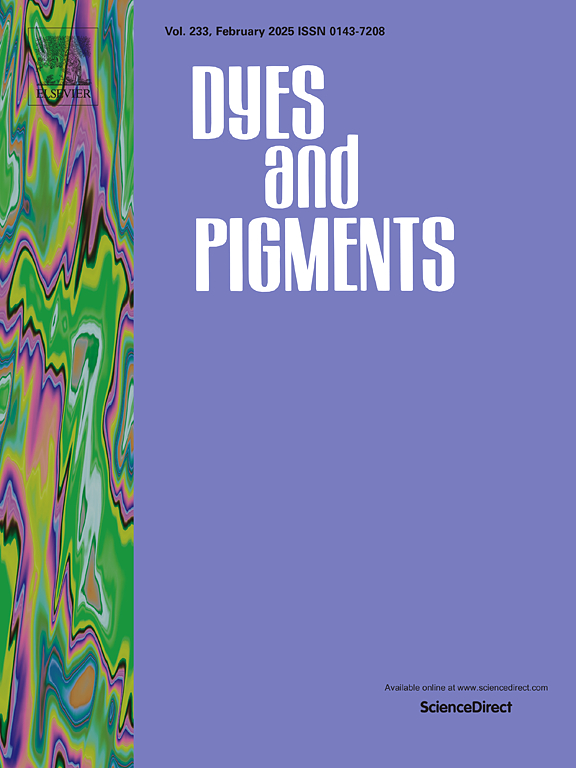“关断”型Cd-MOF荧光传感器用于水溶液中Fe3+、Cr6+和抗生素的鉴定和检测
IF 4.2
3区 工程技术
Q2 CHEMISTRY, APPLIED
引用次数: 0
摘要
采用水热法制备了一种新型镉配位聚合物[Cd(HEA)(L1)]n(1),并证明了其作为一种多功能荧光探针可用于检测水溶液中的重金属离子和抗生素。该化合物具有独特的二维层状结构,可自组织成坚固的三维框架,具有优异的热稳定性和显著的溶剂耐受性。荧光研究强调了配合物1出色的金属离子检测能力,对Fe3+的检测限为0.01434 μM,对Cr6+的检测限为0.05949 ~ 0.06148 μM。此外,该材料对特定抗生素表现出选择性荧光猝灭,对奥硝唑(ODZ)和硝基呋喃酮(NFZ)的检出限分别为0.0369 μM和0.0687 μM。值得注意的是,该材料在连续五个使用周期中保持了其荧光特性。综合实验研究和理论计算表明,荧光猝灭过程涉及多种机制的协同作用,主要包括:静态猝灭、动态猝灭、竞争吸收和光致电子转移途径。这项工作为水系统中痕量重金属和抗生素的传感提供了一种有前途的策略,为发展先进的环境监测方法提供了宝贵的贡献。本文章由计算机程序翻译,如有差异,请以英文原文为准。

“Turn-off” Cd-MOF fluorescence sensor for identification and detection of Fe3+, Cr6+ and antibiotics in aqueous solutions
A newly developed cadmium coordination polymer, [Cd(HEA)(L1)]n (1), was prepared via a hydrothermal method and demonstrated to function as a multifunctional fluorescent probe for detecting heavy metal ions and antibiotics in aqueous solutions. The compound exhibits an unique two-dimensional layered structure that self-organizes into a robust three-dimensional framework, showcasing exceptional thermal stability and significant solvent tolerance. Fluorescence studies emphasized the outstanding metal ion detection capabilities of complex 1, which demonstrated a detection limit of 0.01434 μM for Fe3+ and 0.05949–0.06148 μM for Cr6+. Furthermore, the material exhibited selective fluorescence quenching towards specific antibiotics, with detection limits of 0.0369 μM for Ornidazole (ODZ) and 0.0687 μM for Nitrofurazone (NFZ). Notably, the material retained its fluorescent properties over five consecutive usage cycles. Comprehensive experimental studies and theoretical calculations show that the fluorescence quenching process involves the synergistic action of multiple mechanisms, mainly including: static quenching, dynamic quenching, competitive absorption, and light-induced electron transfer pathways. This work presents a promising strategy for sensing trace heavy metals and antibiotics in water systems, offering valuable contributions to the development of advanced environmental monitoring methodologies.
求助全文
通过发布文献求助,成功后即可免费获取论文全文。
去求助
来源期刊

Dyes and Pigments
工程技术-材料科学:纺织
CiteScore
8.20
自引率
13.30%
发文量
933
审稿时长
33 days
期刊介绍:
Dyes and Pigments covers the scientific and technical aspects of the chemistry and physics of dyes, pigments and their intermediates. Emphasis is placed on the properties of the colouring matters themselves rather than on their applications or the system in which they may be applied.
Thus the journal accepts research and review papers on the synthesis of dyes, pigments and intermediates, their physical or chemical properties, e.g. spectroscopic, surface, solution or solid state characteristics, the physical aspects of their preparation, e.g. precipitation, nucleation and growth, crystal formation, liquid crystalline characteristics, their photochemical, ecological or biological properties and the relationship between colour and chemical constitution. However, papers are considered which deal with the more fundamental aspects of colourant application and of the interactions of colourants with substrates or media.
The journal will interest a wide variety of workers in a range of disciplines whose work involves dyes, pigments and their intermediates, and provides a platform for investigators with common interests but diverse fields of activity such as cosmetics, reprographics, dye and pigment synthesis, medical research, polymers, etc.
 求助内容:
求助内容: 应助结果提醒方式:
应助结果提醒方式:


